Once upon a time, the typical business tool belt was sprinkled with digital tools: email marketing software here, website CMS there, and perhaps software for accounting and tracking sales.
In the last decade or so, software has become more intelligent, consumers have become more engaged and easier to learn from … and business owners have become overwhelmed. What was once a manageable tool belt has become an overflowing tool box akin to what you’d find in a construction worker’s pick-up truck.
According to a recent marketing technology study, the average marketer is using around 12 software tools a day — with some using up to 31. And this doesn’t even consider any sales, support, HR, or finance tools those businesses are using, too.
Wow.
As versatile as technology can be, it doesn't necessarily doesn’t solve the challenge of how to manage, connect, and align all of these different tools. With the sheer amount of software and technology on the market today, is it even possible to return to that convenient toolbelt our entrepreneurial forefathers once knew and loved?
Yes — with a platform. Platforms are the key to creating a centralized home base for all of your marketing technology and more.
We compiled this guide to teach you all about platforms, their various applications, and why your business should consider adopting one.
The concept of platforms isn’t new. In fact, platforms are practically as old as civilization itself — dating back to the marketplaces and bazaars of Ancient Rome. In more recent years, shopping malls and auction houses have taken over this brick-and-mortar representation.
Thanks to the rapid rise of technology, platforms have become mainly digital. Scott Brinker, HubSpot’s VP of Platform Ecosystem, defines this type of platform as “a hub, with spokes connecting other products to its center. The hub binds those disparate products together and orchestrates them in a common mission.”
A platform makes it possible to connect tools, teams, data, and processes under one digital roof — it creates that tool belt we discussed above. It’s the nucleus of all systems and allows you to connect all your favorite tools seamlessly using integrations.
Take a look at HubSpot’s Integrations and Applications Marketplace to see some of the integrations that work with your HubSpot software.
Keep reading to learn how platforms work and how they can benefit your business.
How Platforms Work
Traditional businesses follow a linear model of business, where they manufacture products or services and conduct transactions with other businesses or consumers. These businesses also own their inventory, and consumers access them to purchase their inventory.
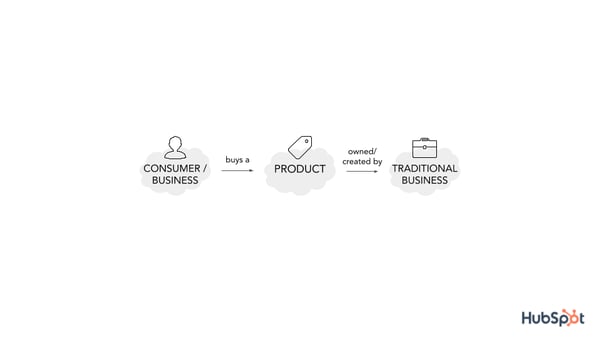
Platform businesses, on the other hand, follow a circular model of business, where they enable and facilitate transactions between two parties without creating, manufacturing, or owning inventory. Consumers use platforms to purchase products or services from other platform users.
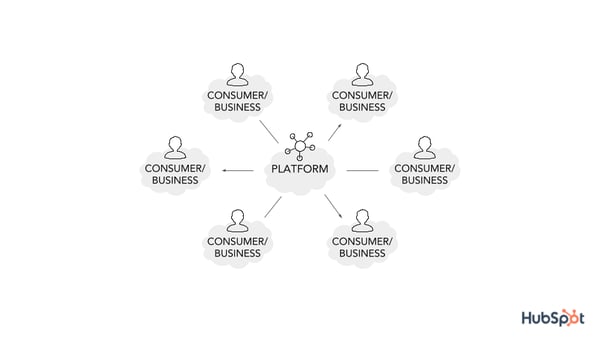
Platforms businesses have proven to be highly valuable — to consumers and investors alike. Did you know that six of the top 10 companies by market capitalization are platforms? That’s right: Apple, Microsoft, Amazon, Alphabet (Google), Facebook, and Alibaba.
It’s clear that in today’s economy, who a company connects with is more important than the product or service they own and sell.
Like we said above, platforms enable interactions and transactions between interdependent groups. These direct interactions inherently create supply (from a seller, service provider, or producer) and demand (from a buyer, service seeker, or consumer) — benefiting both parties.
While traditional businesses create value by creating products or services, platforms create value by enabling these transactions.
Here’s what that transaction typically looks like:
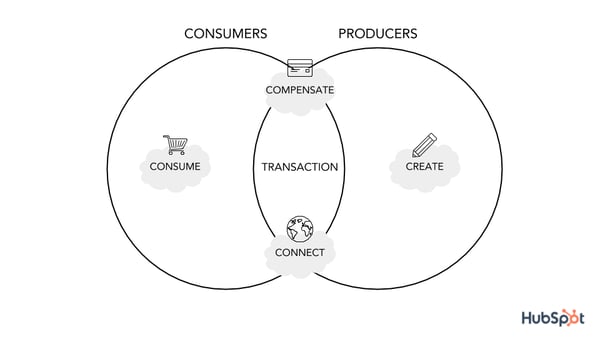
A platform’s success is dependent on more than these transactions, though. Platforms must also attract consumers and producers, enable matches between these two groups, and provide the right technology to aid a transaction — all while maintaining rules and standards that protect both parties as well as the platform itself.
Here’s what the cycle of these four functions typically looks like:
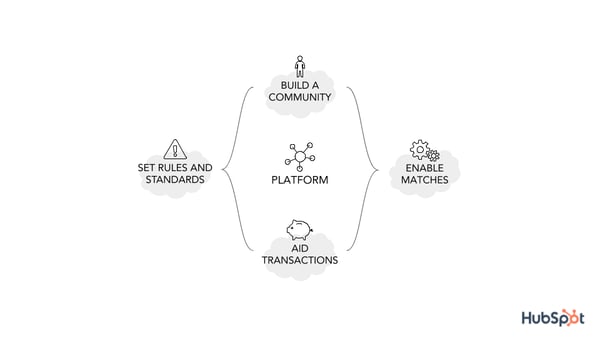
Platform Benefits
The platform business model has revolutionized business and technology as we know it. Here are a few reasons why.
Platform business models grow faster and scale better.
Platforms that follow the platform business model can grow or scale rapidly because they don’t own the resources that create the value, i.e. the applications, content, service providers, or products. Their growth isn’t contingent upon resources or capital.
Platform business models build a reciprocal, self-sufficient community.
Platforms that follow this business model enjoy “two-sided network effects,” meaning that demand is created from the supply of both buyers and sellers, providers and users, or creators and consumers.
This equates to fewer advertising dollars (to attract either buyers or sellers) and stronger word-of-mouth marketing. It also creates a “win-win” situation that allows both the platform business and service providers or sellers to profit from users.
Platforms solve for connection and efficiency issues.
As marketers (or salespeople or support representatives), we tap into dozens of tools each day. In fact, there are almost 7,000 marketing technology vendors globally. Platforms create a centralized location for the tools and applications we use to grow our businesses, reach our customers, and collaborate with our teams.
Time and energy are two things that businesses don’t have to spare. Platforms that follow the platform business model become a one-stop-shop for user’s day-to-day processes.
We’ve defined a platform, and we’ve talked about how platforms have important business ramifications. Next, we’ll cover some real-life platform business model examples, their impact, and how they’ve become successful.
Platform Business Model Examples
How do platforms play out in everyday life? Surprisingly, you’re regularly using more platforms than you realize. Let’s dive into some platform business model examples that will help round out your understanding of the topic.
Airbnb
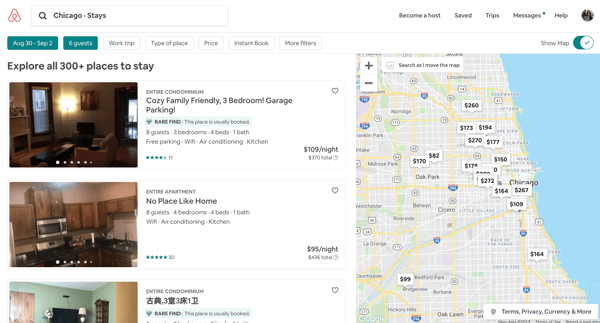
When planning a vacation and deciding where to stay, the first thing I do is hop on my Airbnb app. I could visit a website like Hotels.com or Google to search for places to stay (which are both platforms, too), but I always choose Airbnb. Why? Not only does it allow me to “live like a local” wherever I’m visiting, but it’s relatively affordable and provides me with a wide variety of lodging.
Airbnb has revolutionized the hospitality and lodging industry. For a company that owns no property, it has beat out some of the most popular hotel chains.
Airbnb has also become successful because of its suppliers — normal people like you and me. Airbnb buyers (guests) attract Airbnb suppliers (property owners), therefore fostering a reciprocal ecosystem that benefits both Airbnb and its users alike.
Uber
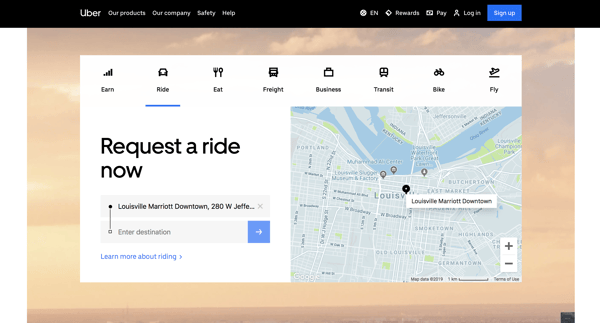
Similar to the way Airbnb doesn't own any properties, Uber doesn’t own any cars … yet it’s given the taxi industry a run for its money. Sure, it’s almost always cheaper, but it also provides a much more modern and arguably safer experience. Riders can pay digitally, split the fare with other riders, and track their ride all the way to the destination.
Uber drivers also receive perks. They control their driving schedule, have access to frequent bonuses, and can find passengers wherever they are — without having to wait at a taxi stand or long queue.
The Uber platform supports both parties. By managing payment, ratings, and all dispute resolutions, Uber makes it easy to be both a driver and rider — and only takes a small percentage of earnings.
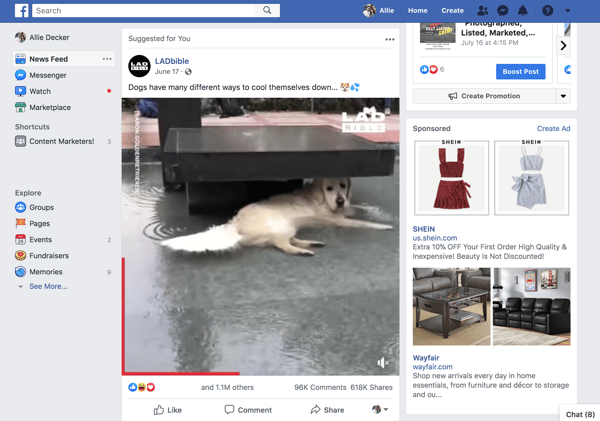
Chances are, you didn’t realize Facebook is a platform. Think about it: Facebook produces no original content and owns no media … yet, it collects data and brings in tons of advertising revenue. Talk about brilliant. In fact, you can consider almost every other social network to be the same.
By creating a fun, interactive place for people to connect and share content, Facebook has built one of today’s most influential platforms. Content created by Facebook users attracts other Facebook users who create more content … so on, and so forth. Facebook is a great example of a platform's reciprocal network effects that create monetization opportunities for the platform itself.
Amazon
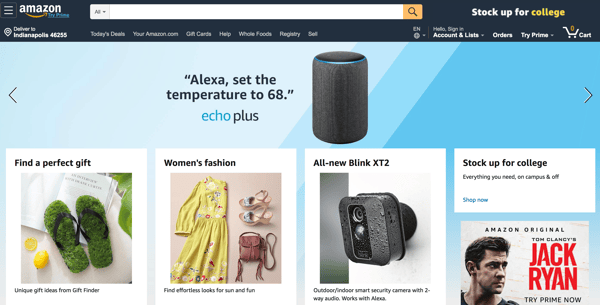
Amazon currently sells over 12 million products to over 310 million active users worldwide — and that product count doesn’t include books, wine, media, and services.
What’s even more fascinating? Amazon doesn’t own the vast majority of the products they sell. Sure, it owns warehouse space, advertising space, a handful of product lines, and now transportation fleets … but it primarily sells other companies’ inventory. It enables (easy, quick, and cheap) transactions between sellers and buyers.
On top of that, Amazon brings in billions from advertising, seller fees, and Prime membership subscriptions.
Medium
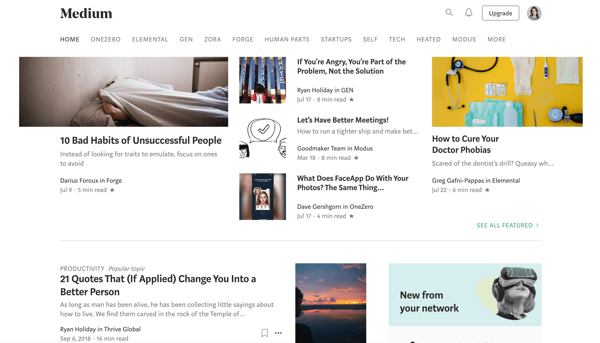
Medium rocked the online publishing world when it was released in 2012. Bloggers, writers, and journalists could publish content online (without cost) without having to worry about hosting a website or getting their work approved by editors. In fact, large news sources and companies — including Sports Illustrated and the White House — started publishing content on Medium, too.
It became a content free-for-all, and readers benefited all the same. Readers could visit Medium and access a variety of fresh content from thousands of writers. As a platform, Medium manages its website … and that’s about it. The corporation doesn’t publish any content of its own, nor does it employ any writers. It simply connects readers and writers to produce and consume great content.
HubSpot
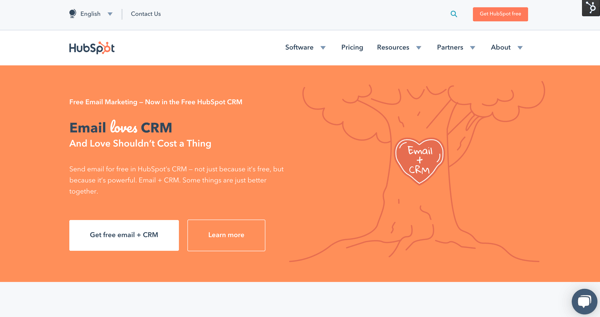
Last year, HubSpot announced that it’s transitioning from an “all-in-one suite vs. all-on-one platform”. This means that it’s expanding to adopt hundreds of more integrations to benefit customers and help them easily expand their tool belt — instead of requiring them to add and master even more disparate systems.
In short, more disconnected software means more friction (and frustration) for customers. Folks are used to either using too many tools that don’t connect or using archaic platforms that don’t solve for today’s buyer (a.k.a. your customers). HubSpot plans to fix that.
The HubSpot platform will allow you to seamlessly connect your tools, teams, data, and processes so you can power frictionless experiences for your customers.
Grow Better With Platforms
Platforms business have revolutionized the economy and how other companies conduct business. Not only do they bring together consumers and producers and create a valuable network, but they also solve countless connection and efficiency issues.
If you’re juggling dozens of marketing tools, consider working with a platform to help streamline your tools, teams, data, and processes. In the meantime, keep an eye out for the platform businesses around you — you might be surprised by how many you already use on a daily basis.
No comments:
Post a Comment